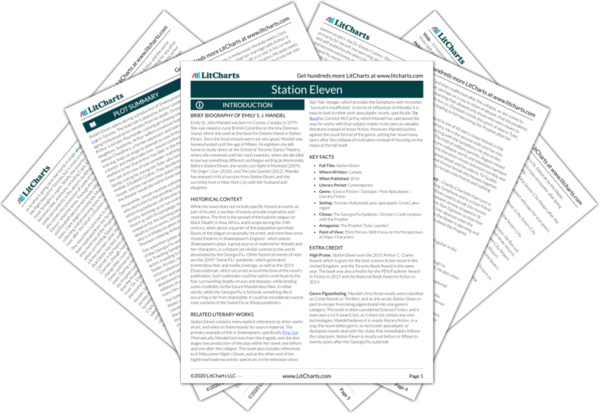Summary
Analysis
Like any group of people who live and travel together, the Traveling Symphony has members who do not get along. The third cello doesn’t like Dieter, who doesn’t like the second horn, who in turn doesn’t like the seventh guitar, and so on. The Symphony finishes their rehearsal, hangs the backdrop that will serve as the setting for the show, and begins to worry why Charlie and the sixth guitar haven’t shown up yet.
Despite the apparent destruction of civilization, the artists of the Traveling Symphony remain essentially human in that they do not all like one another. The absence of Charlie and the sixth guitar is another sign of something off in St. Deborah by the Water.
Themes
While they wait to perform, August reflects on how intense small towns have become. Twenty years after the collapse, civilization consists only of tight-knit small towns that do not often welcome outsiders. August grew up moving from place to place, finding it very difficult to fit in, and the tensions of civilization after the collapse have only made it harder to move into new places. For the actors and musicians, the Traveling Symphony is their only home.
The decimation of the Georgia Flu was so complete that cities are now nonexistent. The primary unit of civilization has now become tiny towns and scattered settlements. But the Symphony members don’t even have a small town to call home—rather, the road, the continuous journey, and the Symphony itself are their home.
Themes
After these reflections, Kirsten decides to take a walk and look for Charlie, since the two were close friends. As she walks through the town, Kirsten notices that it is more abandoned than the last time the Symphony passed through. She also sees a strange symbol – a lowercase t with an extra line toward the bottom – marking a door. Kirsten then knocks on the door of the abandoned Wendy’s where Charlie and her husband moved in two years ago, but they are nowhere to be found.
Again, we note that the town is strange and changed, as it seems empty and is marked by a symbol that Kirsten cannot understand. The Wendy’s where Charlie and the sixth guitar settled two years ago is another example of a repurposed building or remnant of modern civilization.
Themes
Instead, Kirsten meets strangers, along with Maria, whom she recognizes as the local midwife. Maria tells Kirsten that Charlie and Jeremy (the sixth guitar) had their child (Annabel), and that they had to leave. Maria then covertly tells Kirsten that they left because Charlie rejected the prophet’s advances. She tells Kirsten to stop asking questions and to urge the Symphony to leave as quickly as possible.
Here we learn that the town’s strange feeling has come from a religious figure: the prophet. Maria’s warning that the Symphony should leave suggests that there is more danger in St. Deborah in the Water as opposed to mere creepiness.
Themes
Get the entire Station Eleven LitChart as a printable PDF.

As if the town weren’t already strange enough, as Kirsten leaves the Wendy’s she notices that a young girl has been following her. As Kirsten wonders where Charlie is, Dieter quickly approaches her on the road. She fills him in on what she learned from Maria, and he shows her the disturbing sight he found: a large graveyard including the grave markers for Charlie, Jeremy, and Annabel. Dieter notes that their graves are marked, but there is no one buried beneath the markers. Afraid for the lives of their friends, they try to question the little girl, but she becomes frightened and runs away.
Graveyards are essential for any town after the mass death of the collapse, but the haunting grave markers for unburied bodies are extremely disturbing to Kirsten and Dieter. The markers suggest a strange religious practice and continue the building tension surrounding the prophet and the presence of faith in the town.
Themes
Back at the camp at the Walmart, the tuba player recounts what he has learned on his own exploration. He says that St. Deborah by the Water experienced a mini-epidemic, where thirty people died including the mayor. After this epidemic there was a cryptic “change in management,” after which some twenty families left the town, including Charlie and the sixth guitar. Kirsten informs the Symphony that she learned there is a prophet in the town. Under the leadership of the conductor and Gil, the director, the Symphony decides to perform as planned and ask questions after.
Apparently the thirty who died the town’s mini-epidemic, which might have been prevented with the benefits of modern medicine, fill much of the space in the graveyard Dieter discovered. This illness left a power vacuum that enabled the prophet to take over, which drove around twenty others to leave the town. Despite this knowledge, the Symphony decides to perform and share their art with the town anyway.
Themes












